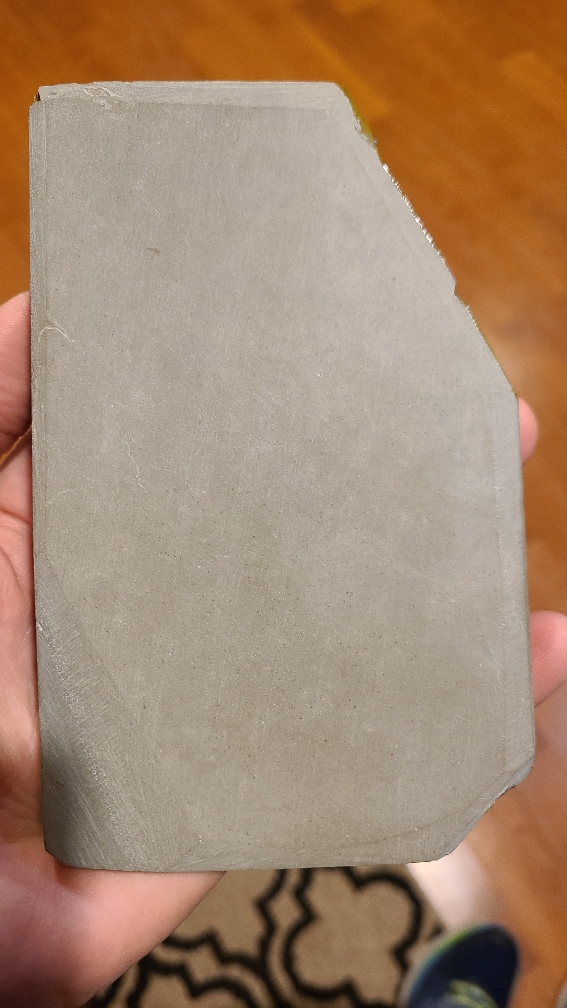I received my first jnat this week - a 5.6 x 3.1 x 0.8 inch Nakayama Asagi Koppa from Keith on Etsy. I am very happy with the stone. The size is perfect for hand-holding, and there is something magical about the stone's feel/texture. Turns out I am on vacation at home this week, so I have lots of time to hone and play. I have now used the stone twice.
Here is the stone straight out of the box.

For my first bout, I honed a shave-ready GD that I had previously performed a full Arkansas progression on followed by 0.5 micron diamond paste. I used the little tomo that came with the stone to raise some slurry and then spent about 20 minutes on the razor just trying to get the lay of the land - medium to light to close to zero pressure using small circles and then x-strokes. The results were not bad, but the razor was not what I will call 0.5 micron shave ready.
At this point, it was pretty clear that I was facing two challenges: 1) just gaining proficiency at honing, and 2) gaining proficiency with jnats. To this point, I had been holding the razor with two hands, using the non-dominant hand to make sure the razor was laying flat on the stone. So I spent a bunch of time practicing circles and x-strokes using the two grips used by @gary haywood in the following video, and now using one hand I can keep the blade flat on the stone through complete strokes, and feel the blade on the stone, including the nose/toe and heel. By no means perfect and there are a few spots in my strokes where I struggle to maintain this feel. But definitely progress. I have avoided using half strokes.
For today's bout, I used a second 0.5 micron shave-ready GD. I raised this slurry using a worn out 600 grit DMT card to eliminate the tomo from the equation.

I then spent about 20 minutes using small circles followed by x-strokes in the slurry with moderate pressure gradually diluting the slurry. The good news is that I had sufficient control to be able to push the slurry from end to end across the entire length of the blade. It turned into a bit of a game - pushing slurry from end to end. Here's what things looked like after working the slurry.

Then I gradually diluted the slurry down to all water using lighter stokes toward the finishing line, and stropped the razor on canvas then leather. The resulting edge passes the forearm hair test and HHT, and feels pretty smooth on my cheek but still not what I will call 0.5 micron sharp.
So my question is what should I focus on to increase the sharpness of the hone? Does the sharpness come from when the slurry is the thickest or later in the process? More pressure? Do I want to see any sign of metal in the worked slurry?
Here is the stone straight out of the box.
For my first bout, I honed a shave-ready GD that I had previously performed a full Arkansas progression on followed by 0.5 micron diamond paste. I used the little tomo that came with the stone to raise some slurry and then spent about 20 minutes on the razor just trying to get the lay of the land - medium to light to close to zero pressure using small circles and then x-strokes. The results were not bad, but the razor was not what I will call 0.5 micron shave ready.
At this point, it was pretty clear that I was facing two challenges: 1) just gaining proficiency at honing, and 2) gaining proficiency with jnats. To this point, I had been holding the razor with two hands, using the non-dominant hand to make sure the razor was laying flat on the stone. So I spent a bunch of time practicing circles and x-strokes using the two grips used by @gary haywood in the following video, and now using one hand I can keep the blade flat on the stone through complete strokes, and feel the blade on the stone, including the nose/toe and heel. By no means perfect and there are a few spots in my strokes where I struggle to maintain this feel. But definitely progress. I have avoided using half strokes.
For today's bout, I used a second 0.5 micron shave-ready GD. I raised this slurry using a worn out 600 grit DMT card to eliminate the tomo from the equation.
I then spent about 20 minutes using small circles followed by x-strokes in the slurry with moderate pressure gradually diluting the slurry. The good news is that I had sufficient control to be able to push the slurry from end to end across the entire length of the blade. It turned into a bit of a game - pushing slurry from end to end. Here's what things looked like after working the slurry.
Then I gradually diluted the slurry down to all water using lighter stokes toward the finishing line, and stropped the razor on canvas then leather. The resulting edge passes the forearm hair test and HHT, and feels pretty smooth on my cheek but still not what I will call 0.5 micron sharp.
So my question is what should I focus on to increase the sharpness of the hone? Does the sharpness come from when the slurry is the thickest or later in the process? More pressure? Do I want to see any sign of metal in the worked slurry?
